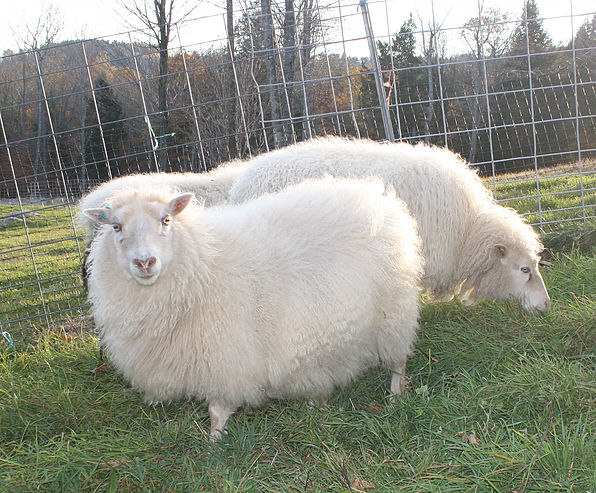Fostering or Grafting Lambs
There have been a few occasions on which I have had to try to convince a ewe to accept a lamb that is not her own. Hopefully, my experience can help you if the need arises. I have successfully grafted lambs at least 4 times that I can easily remember. The circumstances varied…a ewe has a still born lamb, a lamb dies after within a day after birth, mom has twins and only half an udder, a ewe dies or is euthanized after delivery, are some of the reasons. Another could be giving a triplet to a mature mom who has had a single…thereby raising 2 sets of twins, or giving a twin from a ewe lamb to a mature mom with a single.
I have grafted lambs using hints from my mentors, and information garnered from various lambing texts. I do this in a lambing jug set-up so that the situation is controlled. It could be difficult in an open pasture. You will need a basin, a couple buckets of warm water, the placenta or “some birth fluid” from the mom you want to take the new lamb,OB lubricant, soap to wash your hands, and a towel or two. Optional handy things to have are Oxytocin (an injectable hormone that stimulate uterine contractions from your vet) which can be handy to have on hand anyway,a syringe and needle, surgical gloves if you use them,a couple good size plastic bags,soft twine (like cotton kitchen twine) if the lamb to be grafted is up and walking.
 If you know that you may have a problem situation and may need to graft a lamb, try to save the placenta or birth fluids from the ewe that is to receive the new lamb. If her lamb is stillborn, save the dead lamb and placenta in a bucket. If you are going to give a ewe an extra lamb, try to save her placenta and any birth fluid or tissues from her own live lamb in a plastic bag.
If you know that you may have a problem situation and may need to graft a lamb, try to save the placenta or birth fluids from the ewe that is to receive the new lamb. If her lamb is stillborn, save the dead lamb and placenta in a bucket. If you are going to give a ewe an extra lamb, try to save her placenta and any birth fluid or tissues from her own live lamb in a plastic bag.
Here’s the situation, a ewe has a stillborn full term lamb…she has a nice udder. Put this ewe in a lambing jug and leave her lamb with her but take the placenta and put it in a plastic bag. Another ewe is lambing at the same time, or with in 24 hours…you are going to snatch her second or even better 3rd lamb..so keep an eye on her! This is the easiest way to get a lamb for the mom that lost her lamb. Take the newborn before the mom has had a chance to really see it and get her interested in her first lamb. Take the new lamb to the jug where the recipient ewe is. Take the dead lamb from the jug and put it in a basin with warm water. Take the live lamb and wash it in a clean bucket of warm water to wash off the original birth fluids and the smell from it’s mom, dry it a little and put it in the basin with the dead lamb. Take the placenta from the recipient mom and rub it over the live lamb and place the lamb on a towel. Give the recipient ewe an IM injection of 1.5ml of Oxytocin, wash your hand, lubricate your hand (or gloved hand) and insert your hand into the vagina of the ewe. With your index finger gently massage the cervix, then with your hand in a fist, gently massage the cervix and vagina, with a motion causing pressure on then off the cervix. The ewe will have contractions because of the Oxytocin and the stimulation. Do this gently, with much lubrication for a full minute or two, then, present her with the live lamb. Wipe any fluid on your hand onto the lamb. The lamb will be trying to stand…encourage her to lick the lamb. If she is skitterish, move away and leave the two alone..watch from a distance. Once she is licking the lamb, get the lamb nursing as soon as possible. The sooner that udder stimulation is happening the better the bonding.
Be patient and gentle. You may have to stimulate contractions manually again to get the ewe interested. Stay calm and move slowly, you don’t want to add to the distraction or stress. The worst that will happen is you have a bottle baby ( and that isn’t so bad!) If you took a lamb from a set of twins or triplets, you can’t give that lamb back to the birth mom, unless you follow this same procedure , so be careful in your choice.
 If the lamb to be grafted is from a dead mother, the situation is a little different. If there isn’t a ewe lambing, you will have to give that newborn a bottle of colostrum milked from another ewe ( or from your frozen stash) until there is an appropriate recipient mom. I find it helpful to wash the lamb in clean warm water too. If you had a ewe that had a single and could easily handle twins and your were fortunate to have saved her placenta, the procedure is nearly the same. You will wash the lamb, and then put it in a basin of a little warm water and stick the ewe’s own lamb in there too. Give the Oxytocin and do the internal stimulation if the ewe is within 24 hours or less from having given birth. You will use the soft twine to tie the legs of the lamb to be grafted. Tie the front legs together, and the back legs together. The ewe is less suspicious if the “graftee“ isn’t running around. It will struggle to get up , much like a newborn. Put it in with the ewe and her other lamb in a jug, so the original lamb can’t be running off, taking mom with it. If mom is ignoring the new lamb , tie the legs of the other lamb and put the two together in front of the ewe. Get the new lamb to nurse as soon as you can. You may have to take the original lamb away to let mom bond with the new one. You can put more of the “placenta water” on the two lambs if needed., especially on the butt end of the lambs, and the top of the head.
If the lamb to be grafted is from a dead mother, the situation is a little different. If there isn’t a ewe lambing, you will have to give that newborn a bottle of colostrum milked from another ewe ( or from your frozen stash) until there is an appropriate recipient mom. I find it helpful to wash the lamb in clean warm water too. If you had a ewe that had a single and could easily handle twins and your were fortunate to have saved her placenta, the procedure is nearly the same. You will wash the lamb, and then put it in a basin of a little warm water and stick the ewe’s own lamb in there too. Give the Oxytocin and do the internal stimulation if the ewe is within 24 hours or less from having given birth. You will use the soft twine to tie the legs of the lamb to be grafted. Tie the front legs together, and the back legs together. The ewe is less suspicious if the “graftee“ isn’t running around. It will struggle to get up , much like a newborn. Put it in with the ewe and her other lamb in a jug, so the original lamb can’t be running off, taking mom with it. If mom is ignoring the new lamb , tie the legs of the other lamb and put the two together in front of the ewe. Get the new lamb to nurse as soon as you can. You may have to take the original lamb away to let mom bond with the new one. You can put more of the “placenta water” on the two lambs if needed., especially on the butt end of the lambs, and the top of the head.
The procedure may seem a bit complicated but really it is not difficult. Having a mom for the lamb is good for both of them…or having a mature ewe that can more easily raise two, will let the ewe lamb first time mother raise a big fat single instead of two smaller twins. Remember, if it doesn’t work, you will have a bottle baby ,or you can move on to try the head gate method of grafting a lamb. I haven’t had to use a head gate, this has worked quite well for me.
I always encourage shepherds to have a copy of Laura Lawson’s Managing Your Ewe, it has helped me many times. My copy is dog-eared and stained with “stuff” but is there in the lambing barn to offer support and a refresher course year to year. Never be afraid to try to help a lamb…you may save it’s life, but even if you can’t, you will have learned valuable skills to save another one day. If I can be of help, email or call me. If it’s an emergency, call any time. If it’s not emergent, kindly call between 8am and 8pm Have a joyful Spring and best of luck with your lambing.
![]()


